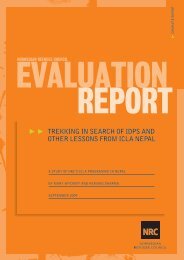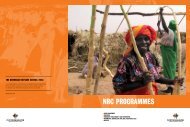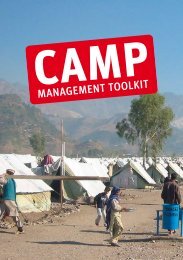evaluation of general food distribution in northern uganda: gulu ...
evaluation of general food distribution in northern uganda: gulu ...
evaluation of general food distribution in northern uganda: gulu ...
You also want an ePaper? Increase the reach of your titles
YUMPU automatically turns print PDFs into web optimized ePapers that Google loves.
Annex 5: Traditional nutrition and diet <strong>in</strong> Northern Uganda – By Jane OryemThe traditional (pre IDP camps) nutrition and dietary system <strong>in</strong> Northern Uganda (Acholi sub -region compris<strong>in</strong>gthe districts <strong>of</strong> Kitgum, Pader, Amuru and Gulu) consisted <strong>of</strong> the staples such as Millet and Sim -Sim, fruits,vegetables, poult ry, meat (fresh and Game) and seasonal delicacies. The Acholi had a variety <strong>of</strong> <strong>food</strong>s accessibleto every family. Apart from nutritional values there some <strong>food</strong> elements culturally favoured for the growth <strong>of</strong>children, to help <strong>in</strong>crease breast milk for nurs<strong>in</strong> g mothers ,some to <strong>in</strong>crease vitality <strong>in</strong> young men.Sources <strong>of</strong> Food• Practically every family kept poultry, a few goats and sheep, which were reared, <strong>in</strong> and around thehomestead. Many families kept cattle reared with<strong>in</strong> the village (with the help <strong>of</strong> the B alaloo People whokept most <strong>of</strong> the milk for sale). The wealthy families had large farms with hundreds <strong>of</strong> herds.• Around each homestead, there were plots <strong>of</strong> land for grow<strong>in</strong>g vegetables like Malakwang (a bitter-sourbut delicious and nutritious vegetable) , Boo (the staple vegetable <strong>of</strong> the Acholi) Akeyo, Oyado (Greenvegetables) pumpk<strong>in</strong>, tomatoes, cabbages, beans and Irish Potatoes. The homestead plots were alsoused to grow cassava, sweet potatoes, maize (for cob consumption as opposed to produc<strong>in</strong>g flour) andfruits like mangoes, pawpaw, oranges, lemon, guavas and tanger<strong>in</strong>es.• A mile or two from the homesteads were the ma<strong>in</strong> family gardens <strong>of</strong> small farms where millet andsimsim (the ma<strong>in</strong> staple <strong>food</strong> <strong>of</strong> the Acholi), were grown. Other ma<strong>in</strong> <strong>food</strong> crops grown here <strong>in</strong>c ludedLapena (Chick peas), groundnuts, sorghum for brew<strong>in</strong>g beer (sometimes sorghum was mixed withcassava flour <strong>in</strong> times <strong>of</strong> a poor millet harvest).• Each family had a m<strong>in</strong>imum <strong>of</strong> two granaries ( dero) to store millet and simsim. The size and number <strong>of</strong>the granaries depended on the size <strong>of</strong> the family and wealth. The <strong>food</strong> stored would always last past thenext harvest. Other granaries were built to store peas and groundnuts.• Around the family gardens, <strong>in</strong> the communal graz<strong>in</strong>g fields, by the rivers and <strong>in</strong> the fore sts there werelots <strong>of</strong> fruit trees and anyone could collect these fruits. Among these were Shea nut trees (Yaa) whosefruits conta<strong>in</strong> the seeds from which –Shea butter (Moo Yaa) was extracted. Moo Yaa was ma<strong>in</strong>ly used <strong>in</strong>sauces, but also served as a body lot ion for women and children. Other fruit trees <strong>in</strong>clude Tugu (palmtree), Cwaa (Tamar<strong>in</strong>d), Langoo, Ocoga, Oywelo, and many others.• People had Bee hives ( Bong) <strong>in</strong> communal graz<strong>in</strong>g areas or forests for honey. Some <strong>in</strong>dividuals werealso known to lay claim on ho ney troves found <strong>in</strong> some hollow trees, those claims were accepted andrespected by the rest <strong>in</strong> the village. They would then periodically extract honey from that tree. Thesesorts <strong>of</strong> claims also applied to fresh anthills <strong>in</strong> the communal land (but not <strong>in</strong> som eone’s garden). Theowner <strong>of</strong> the anthill would then trap White Ants ( Ngwen) from the anthill every season.• Grasshoppers ‘ Nsenene’ ( Ocene) or fungi like mushrooms Obwol) were also popular seasonaldelicacies.• Dur<strong>in</strong>g the Dry Season (November to February), there were jo<strong>in</strong>t hunt<strong>in</strong>g sessions <strong>in</strong> the forests <strong>in</strong> whichthe entire village was <strong>in</strong>volved. Most <strong>of</strong> the hunt<strong>in</strong>g was, however carried out by lone hunters (Oken) withtheir dogs around the bushes and forests <strong>in</strong> the area. The hunters are mostly very successful (Buffalo,Antelopes, field rats) and they sold most <strong>of</strong> their game and fish (either fresh or smoked) to the people.The average family also set traps for small animals like rabbits and birds like Gu<strong>in</strong>ea Fowls (Aweno) <strong>in</strong>and around their gardens.It should also be noted that, throughout Acholi land, Saturdays and or Wednesdays are “Market days”. Peoplebrought their produce to the central market (<strong>in</strong> each village) and used the money to buy other produce orsupplement their <strong>in</strong>come. These two days are normally when cows are slaughtered and people could buy and eatfresh meat. Those who could not afford to buy fresh meat or game on a Saturday used chicken as a substitute.Goats and sheep were slaughtered when there were special family functions or occasions <strong>of</strong> c ultural importance.3
















